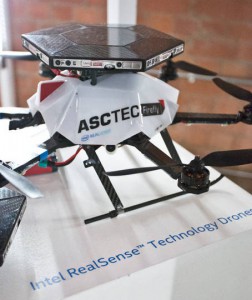
Looking to get into homes, and with an eye on start-ups, is was showing a home gateway based around the firm’s Galileo development board.
“It allows makers to come up with their own home automation system by providing a cross-platform central hub that can talk to any of the smart devices already on the market,” said Intel. “So if you’ve got a Nest thermostat and Philips Hue lightbulbs, for example, the Home Gateway will provide the link between the two.”
The system is based on NFC tags that track people in the home to adjust devices accordingly as they move around – re-streaming a film from living room TV to kitchen tablet whilst you make a cup of tea, for example.
RealSense was another technology it is pushing.
While it looks like this brand may cover more than one technology, overall it covers 3D optical depth sensing. A version of it was demonstrated in HP Sprout.
Sprout is a device with at touch screen and more: “you control your content and activities with waving, pinching, grabbing and even smiling at it”, said Intel.
 Beyond this it is hoping the technology will be used not just to add gesture recognition into tablets and phones, but to add 3D scanning to devices. “As just one example, 3DMe takes photography into the third dimension and allows you to animate or even 3D print yourself as your favourite character,” said Intel, which showed a 3D photo of someone in a block of glass.
Beyond this it is hoping the technology will be used not just to add gesture recognition into tablets and phones, but to add 3D scanning to devices. “As just one example, 3DMe takes photography into the third dimension and allows you to animate or even 3D print yourself as your favourite character,” said Intel, which showed a 3D photo of someone in a block of glass.
At longer range, it proposes RealSense as a way to give drones a local 3D map for object avoidance.
Current products on-show included the Intel NUC, Compute Stick (PC with HDMI connector), Galileo Gen 2 (Arduino-style board with X86 processor) and Edison on an Arduino-style board.
 Electronics Weekly Electronics Design & Components Tech News
Electronics Weekly Electronics Design & Components Tech News


